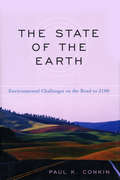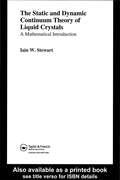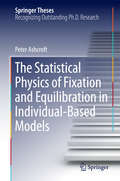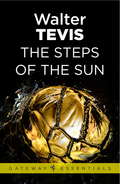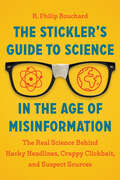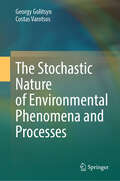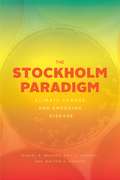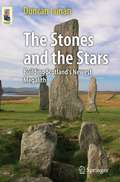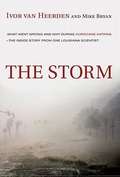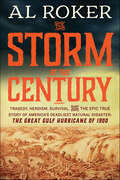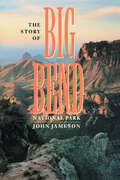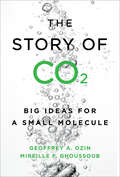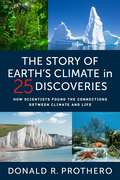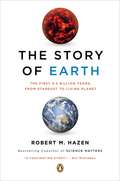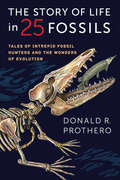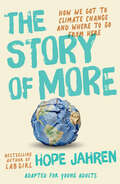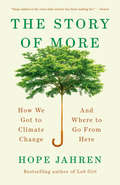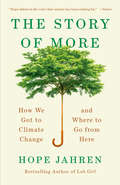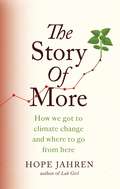- Table View
- List View
The State of the Earth: Environmental Challenges on the Road to 2100
by Paul K. ConkinAn assessment of where we are, where we&’re headed, and what we need to do before it&’s too late: &“Instructive, well-researched, and easy-to-read.&” —John T. Ackerman, Strategic Studies Quarterly This era of staggering scientific and technological innovations, with major changes in agriculture, manufacturing, commerce, and communications, seems to document unparalleled human achievement. Yet when we examine the long-term implications, it becomes clear that the delicate environmental balance that sustains life on this planet is under serious threat, and the past century may be remembered not as a period of great progress but as one marked by unrestrained consumption and failure to come close to a sustainable use of the earth&’s limited natural resources. In The State of the Earth, noted historian Paul K. Conkin provides a comprehensive analysis of the many environmental hazards that humans must face in this still-young century. Our activities have threatened the survival of many plants and animals, created scarcities in cultivatable soils and water needed for irrigation, used up a large share of fossil fuels, polluted air and water, and most likely created conditions that will lead to devastating climate changes. This is an invaluable resource for those who desire a broad yet thorough and scientifically informed introduction to present environmental challenges.
The Static and Dynamic Continuum Theory of Liquid Crystals: A Mathematical Introduction (Liquid Crystals Book Series)
by Iain W. StewartGiven the widespread interest in macroscopic phenomena in liquid crystals, stemming from their applications in displays and devices. The need has arisen for a rigorous yet accessible text suitable for graduate students, whatever their scientific background. This book satisfies that need.The approach taken in this text, is to introduce the basic continuum theory for nematic liquid crystals in equilibria, then it proceeds to simple application of this theory- in particular, there is a discussion of electrical and magnetic field effects which give rise to Freedericksz transitions, which are important in devices. This is followed by an account of dynamic theory and elementary viscometry of nemantics Discussions of backflow and flow-induced instabilities are also included. Smetic theory is also briefly introduced and summarised with some examples of equilibrium solutions as well as those with dynamic effects. A number of mathematical techniques, such as Cartesian tensors and some variational calculus, are presented in the appendices.
The Statistical Mechanics of Irreversible Phenomena
by Pierre GaspardThis book provides a comprehensive and self-contained overview of recent progress in nonequilibrium statistical mechanics, in particular, the discovery of fluctuation relations and other time-reversal symmetry relations. The significance of these advances is that nonequilibrium statistical physics is no longer restricted to the linear regimes close to equilibrium, but extends to fully nonlinear regimes. These important new results have inspired the development of a unifying framework for describing both the microscopic dynamics of collections of particles, and the macroscopic hydrodynamics and thermodynamics of matter itself. The book discusses the significance of this theoretical framework in relation to a broad range of nonequilibrium processes, from the nanoscale to the macroscale, and is essential reading for researchers and graduate students in statistical physics, theoretical chemistry and biological physics.
The Statistical Physics of Fixation and Equilibration in Individual-Based Models
by Peter AshcroftThis thesis explores several interdisciplinary topics at the border of theoretical physics and biology, presenting results that demonstrate the power of methods from statistical physics when applied to neighbouring disciplines. From birth-death processes in switching environments to discussions on the meaning of quasi-potential landscapes in high-dimensional spaces, this thesis is a shining example of the efficacy of interdisciplinary research. The fields advanced in this work include game theory, the dynamics of cancer, and invasion of mutants in resident populations, as well as general contributions to the theory of stochastic processes. The background material provides an intuitive introduction to the theory and applications of stochastic population dynamics, and the use of techniques from statistical physics in their analysis. The thesis then builds on these foundations to address problems motivated by biological phenomena.
The Steps of the Sun: From the author of The Queen's Gambit – now a major Netflix drama (Gateway Essentials #510)
by Walter TevisA science fiction thriller from the author of THE MAN WHO FELL TO EARTH.'A fine engrossing novel by a master!' Philadelphia EnquirerIn a time when America's power has been eroded by energy depletion, and world control has been virtually given over to the Chinese, only one man has the courage to seek new mineral resources among the stars. He is Ben Belson, one of the richest men in the world, a man haunted by the memory of a loveless childhood and driven by needs and desires he can barely understand or control. His dream is to find the means to help America break the stranglehold of the corrupt interests who are keeping it a second class power.
The Steps of the Sun: From the author of The Queen's Gambit – now a major Netflix drama (Gateway Essentials #510)
by Walter TevisA science fiction thriller from the author of THE MAN WHO FELL TO EARTH.'A fine engrossing novel by a master!' Philadelphia EnquirerIn a time when America's power has been eroded by energy depletion, and world control has been virtually given over to the Chinese, only one man has the courage to seek new mineral resources among the stars. He is Ben Belson, one of the richest men in the world, a man haunted by the memory of a loveless childhood and driven by needs and desires he can barely understand or control. His dream is to find the means to help America break the stranglehold of the corrupt interests who are keeping it a second class power.
The Stickler's Guide to Science in the Age of Misinformation: The Real Science Behind Hacky Headlines, Crappy Clickbait, and Suspect Sources
by R. Philip BouchardThe Real Science Behind Hacky Headlines, Crappy Clickbait, and Suspect SourcesWe have more scientific information at our fingertips today than ever before. And more disinformation too. Online, on television, and in print, science is often communicated through shorthand analogies and phrases that obscure or omit important facts. &“Superfoods,&” &“right- and left-brained&” people, and &“global warming&” may be snappy and ear-catching but are they backed by scientific facts? Lifelong educator R. Philip Bouchard is a stickler for this kind of thing, and he is well-prepared to set the record straight.The Stickler&’s Guide to Science in the Age of Misinformation unpacks the many misuses of terms we see used every day, revealing how these popular &“scientific&” concepts fall short of real science. Find out why trees do not &“store&” carbon dioxide; a day is not actually 24 hours; DNA cannot provide a &“blueprint&” for a human being; and an absence of gravity is not the reason that astronauts float in space.With The Stickler&’s Guide to Science in the Age of Misinformation, Bouchard makes hard science go down easy, satisfying curiosity and sparking further inquiry that will keep you from getting fooled again.
The Stochastic Nature of Environmental Phenomena and Processes
by Costas Varotsos Georgy GolitsynThis book is useful not only for young but also for mature scientists who are preparing methods for studying natural environmental phenomena and their alteration by human activity. As spatio-temporal scales of natural environmental phenomena become larger, the variance of their fluctuations increases or decreases over wide ranges. Such signals appear not only in environmental dynamics but everywhere, even in seemingly unrelated fields. When one looks at these signals more closely, one finds that they are governed by specific, measurable scaling laws, that is, a statistical relationship between big and small, between fast and slow. In this book, the authors describe and explain processes that have puzzled environmental science for decades, such as the climate crisis, clouds, turbulence, earthquakes, cosmic rays, sea wind waves, hurricanes, floods, radiation field in the climate system, ozone hole, greenhouse effect, air pollution, El Nino / La Nina, nowcasting models.
The Stockholm Paradigm: Climate Change and Emerging Disease
by Daniel R. Brooks Eric P. Hoberg Walter A. BoegerThe contemporary crisis of emerging disease has been a century and a half in the making. Human, veterinary, and crop health practitioners convinced themselves that disease could be controlled by medicating the sick, vaccinating those at risk, and eradicating the parts of the biosphere responsible for disease transmission. Evolutionary biologists assured themselves that coevolution between pathogens and hosts provided a firewall against disease emergence in new hosts. Most climate scientists made no connection between climate changes and disease. None of these traditional perspectives anticipated the onslaught of emerging infectious diseases confronting humanity today. As this book reveals, a new understanding of the evolution of pathogen-host systems, called the Stockholm Paradigm, explains what is happening. The planet is a minefield of pathogens with preexisting capacities to infect susceptible but unexposed hosts, needing only the opportunity for contact. Climate change has always been the major catalyst for such new opportunities, because it disrupts local ecosystem structure and allows pathogens and hosts to move. Once pathogens expand to new hosts, novel variants may emerge, each with new infection capacities. Mathematical models and real-world examples uniformly support these ideas. Emerging disease is thus one of the greatest climate change–related threats confronting humanity. Even without deadly global catastrophes on the scale of the 1918 Spanish Influenza pandemic, emerging diseases cost humanity more than a trillion dollars per year in treatment and lost productivity. But while time is short, the danger is great, and we are largely unprepared, the Stockholm Paradigm offers hope for managing the crisis. By using the DAMA (document, assess, monitor, act) protocol, we can “anticipate to mitigate” emerging disease, buying time and saving money while we search for more effective ways to cope with this challenge.
The Stokes Guide to Finches of the United States and Canada
by Lillian Q. Stokes Matthew A. YoungLearn all you need to know about identifying and attracting finches with this comprehensive, gloriously colorful field guide from America&’s foremost authorities on birds and nature. Following the extraordinary finch superflight of 2020-2021, birders across the country became obsessed with finches. With The Stokes Guide to Finches of the United States and Canada, you can gain expert knowledge on these beautiful birds and bring them into your own yard. This fully illustrated guide tells you all you need to know about attracting, observing, and protecting finches. The book also includes: A special section on endangered Hawaiian honeycreeper finches, plus other rare and vagrant species Detailed identification information on each finch species&’ plumages, subspecies, and voice The most complete and up-to-date range maps, including maps of core occurrence and irruption ranges for all red crossbill call types, which have never before been published in a guide Complete life history information Scientific studies on finch migrations and conservation More than 345 stunning full-color photographs and over 50 range maps covering 43 species
The Stones and the Stars
by Duncan LunanThere are at least 48 identified prehistoric stone circles in Scotland. In truth, very little is known about the people who erected them, and ultimately about what the stone circles were for. Most stone circles are astronomically aligned, which has led to the modern debate about why the alignment was significant. The megaliths certainly represented an enormous co-operative effort, would at the very least have demonstrated power and wealth, and being set away from any dwellings probably served a ceremonial, or perhaps religious, purpose. Observations at the site of the stone circles, of solar, lunar, and stellar events, have already cast light on some of the questions about the construction and use of ancient megalithic observatories. In his capacity as manager of the Parks Department Astronomy Project, author Duncan Lunan designed and built the first astronomically aligned stone circle in Britain in over 3,000 years. 'The Stones and the Stars' examines the case for astronomical alignments of stone circles, and charts the development of a fascinating project with a strong scientific and historical background. The work was documented in detail by the artist and photographer Gavin Roberts, and this archive has been added to since - so an appropriate selection of illustrations will bring the project vividly to life.
The Storm
by Daniel DefoeOn the evening of 26th November 1703, a cyclone from the north Atlantic hammered into southern Britain at over seventy miles an hour, claiming the lives of over 8,000 people. Eyewitnesses reported seeing cows left stranded in the branches of trees and windmills ablaze from the friction of their whirling sails. For Defoe, bankrupt and just released from prison for seditious writings, the storm struck during one of his bleakest moments. But it also furnished him with the material for his first book, and in his powerful depiction of private suffering and individual survival played out against a backdrop of public calamity we can trace the outlines of his later masterpieces such as A Journal of the Plague Year and Robinson Crusoe.
The Storm
by Mike Bryan Ivor Van Heerden Field SketchesThe ultimate inside story: how bureaucracy, politics, and a disregard of science combined to cripple-perhaps forever-a great American city As deputy director of the Louisiana State University Hurricane Center, Ivor van Heerden had for years been warning state and local officials about New Orleans's vulnerability to flooding. But like Cassandra's, his predictions were ignored-until Hurricane Katrina hit on August 29, 2005. Suddenly, van Heerden found himself at the center of a media maelstrom. Stepping forward to challenge the official version of events, he revealed the truth about the city's shoddy levee construction. Now, in The Storm, van Heerden shares up-to-the-minute reporting from his investigations and connects the dots among the Army Corps of Engineers, the bureaucrats, the politicians, and the chain of events-both natural and human-that culminated in catastrophe. An epic of cutting- edge science and systemic bureaucratic failure, The Storm is the first book from a major player in the Katrina disaster and a riveting narrative that brings expertise, passion, and a human viewpoint to America's greatest natural disaster.
The Storm of the Century: Tragedy, Heroism, Survival, and the Epic True Story of America's Deadliest Natural Disaster
by Al RokerIn this gripping narrative history, Al Roker from NBC’s Today and the Weather Channel vividly examines the deadliest natural disaster in American history—a haunting and inspiring tale of tragedy, heroism, and resilience that is full of lessons for today’s new age of extreme weather.On the afternoon of September 8, 1900, two-hundred-mile-per-hour winds and fifteen-foot waves slammed into Galveston, the booming port city on Texas’s Gulf Coast. By dawn the next day, the city that hours earlier had stood as a symbol of America’s growth and expansion was now gone. Shattered, grief-stricken survivors emerged to witness a level of destruction never before seen: Eight thousand corpses littered the streets and were buried under the massive wreckage. Rushing water had lifted buildings from their foundations, smashing them into pieces, while wind gusts had upended steel girders and trestles, driving them through house walls and into sidewalks. No race or class was spared its wrath. In less than twenty-four hours, a single storm had destroyed a major American metropolis—and awakened a nation to the terrifying power of nature.Blending an unforgettable cast of characters, accessible weather science, and deep historical research into a sweeping and dramatic narrative, The Storm of the Century brings this legendary hurricane and its aftermath into fresh focus. No other natural disaster has ever matched the havoc caused by the awesome mix of winds, rain, and flooding that devastated Galveston and shocked a young, optimistic nation on the cusp of modernity. Exploring the impact of the tragedy on a rising country’s confidence—the trauma of the loss and the determination of the response—Al Roker illuminates the United States’s character at the dawn of the “American Century,” while also underlining the fact that no matter how mighty they may become, all nations must respect the ferocious potential of our natural environment.
The Story of Big Bend National Park
by John JamesonThe history of the first national park in Texas—the politics, intrigues, controversies, and the people inspired by the stunning desert environment. A breathtaking country of rugged mountain peaks, uninhabited desert, and spectacular river canyons, Big Bend is one of the United States&’ most remote national parks and among Texas&’ most popular tourist attractions. Located in the great bend of the Rio Grande that separates Texas and Mexico, the park comprises some 800,000 acres, an area larger than the state of Rhode Island, and draws over 300,000 visitors each year. The Story of Big Bend National Park offers a comprehensive, highly readable history of the park from before its founding in 1944 up to the present. John Jameson opens with a fascinating look at the mighty efforts involved in persuading Washington officials and local landowners that such a park was needed. He details how money was raised and land acquired, as well as how the park was publicized and developed for visitors. Moving into the present, he discusses such issues as natural resource management, predator protection in the park, and challenges to land, water, and air. Along the way, he paints colorful portraits of many individuals, from area residents to park rangers to Lady Bird Johnson, whose 1966 float trip down the Rio Grande brought the park to national attention. This history will be required reading for all visitors and prospective visitors to Big Bend National Park. For everyone concerned about our national parks, it makes a persuasive case for continued funding and wise stewardship of the parks as they face the twin pressures of skyrocketing attendance and declining budgets.
The Story of Brutus: My Life with Brutus the Bear and the Grizzlies of North America
by Casey AndersonThe heart-warming story of the incredible friendship between National Geographic star Casey Anderson and an 800-pound grizzly bear named Brutus. Casey Anderson, the host of National Geographic's Expedition Grizzly, met a month-old bear cub in a wildlife preserve in 2002, whom he affectionately named Brutus. Little Brutus was destined to remain in captivity or, more likely, even euthanized due to overpopulation at the preserve. Anderson, already an expert in animal rescue and rehabilitation, just could not let that happen to Brutus, who looked like a "fuzzy Twinkie." From the beginning it was clear something special existed between the two. And so, Anderson built the Montana grizzly encounter in Bozeman, Montana, especially for Brutus, so that he, and others like him, could grow up "being a bear." And so the love story began. When together, Anderson and Brutus will wrestle, swim, play, and continue to act as advocates for grizzly protection and education, be it through documentaries like Expedition Grizzly, appearances on Oprah or Good Morning America, or in this inspiring book, which promises to be an intimate look into Anderson's relationship with Brutus and a call to action to protect these glorious animals and the natural world they live in. The Story of Brutus proves that love and friendship knows no bounds and that every care must be taken to protect one of nature's noblest creatures.
The Story of CO2 Is the Story of Everything: How Carbon Dioxide Made Our World
by Peter BrannenCarbon dioxide. This seemingly simple and ubiquitous substance is fundamental to how our planet works. All life is made from CO2 and its behavior on this planet has kept it bizarrely habitable for hundreds of millions of years. In its workings lie both the splendor of our world—and the potential for life’s destruction. In short, it is the most important substance in Earth’s history.But why is CO2 as essential to life on Earth as it is capable of destroying it? In THE STORY OF CO2 IS THE STORY OF EVERYTHING, award-winning science journalist Peter Brannen reveals carbon dioxide’s fundamental role in the operation and maintenance of Planet Earth. Starting at the beginning of time and working all the way up to our present reality, he illuminates how CO2 has been responsible for the planet’s many deaths and rebirths, for the evolution of life, and for the development of modern human society. Carbon dioxide’s movement through the rocks, the air, the oceans, and life has kept our planet’s climate livable, its air breathable, and its oceans hospitable to complex life for more than 500 million years. And only by understanding CO2 in the context of deep Earth history can we see how it gave rise to today’s industrial economy – and more clearly recognize what it means to be churning through hundreds of millions of years of old life in the form of fossil fuels and converting it all to carbon dioxide. With groundbreaking research and a clear-eyed perspective, Brannen shows how a deep exploration into the mechanics of the carbon cycle and the history of our planet can provide hope for averting environmental catastrophe in the future. It all starts with a richer understanding of the essential role of one substance.
The Story of CO2: Big Ideas for a Small Molecule
by Geoffrey Ozin Mireille GhoussoubThe climate crisis requires that we drastically reduce carbon dioxide emissions across all sectors of society. The Story of CO2 contributes to this vital conversation by highlighting the cutting-edge science and emerging technologies – a number of which are already commercially available – that can transform carbon dioxide into a myriad of products such as feedstock chemicals, polymers, pharmaceuticals, and fuels. This approach allows us to reconsider CO2 as a resource, and to add "carbon capture and use" to our other tools in the fight against catastrophic climate change. The Story of CO2 explores all aspects of carbon dioxide, from the atomic to the universal perspective, and takes the reader on an epic journey into our physical world, starting from the moment of the Big Bang, all the way to the present world in which atmospheric CO2 concentrations continue to grow. This story seeks to inspire readers with the latest carbon utilization technologies and explain how they fit within the broader context of carbon mitigation strategies in the shift towards a sustainable energy economy.
The Story of Earth's Climate in 25 Discoveries: How Scientists Found the Connections Between Climate and Life
by Donald R. ProtheroOver 4.5 billion years, Earth’s climate has transformed tremendously. Before our more temperate recent past, the planet swung from one extreme to another—from a greenhouse world of sweltering temperatures and high sea levels to a “snowball earth” in which glaciers reached the equator. During this history, we now know, living things and the climate have always influenced and even shaped each other. But the climate has never changed as rapidly or as drastically as it has since the Industrial Revolution.In this lively and entertaining book, Donald R. Prothero explores the astonishing connections between climate and life through the ages, telling the remarkable stories of the scientists who made crucial discoveries. Journeying through the intertwined evolution of climate and life, he tackles questions such as: Why do we have phytoplankton to thank for the air we breathe? What kind of climate was necessary for the rise of the dinosaurs—or the mammals, their successors? When and how have climatic changes caused mass extinctions? Prothero concludes with the Ice Ages and the Holocene, the role of climate in human history, and the perils of anthropogenic climate change. Understanding why the climate has changed in the past, this timely book shows, is essential to grasping the gravity of how radically human activity is altering the climate today.
The Story of Earth: The First 4.5 Billion Years, from Stardust to Living Planet
by Robert M. HazenEarth evolves. From first atom to molecule, mineral to magma, granite crust to single cell to verdant living landscape, ours is a planet constantly in flux. In this radical new approach to Earth’s biography, senior Carnegie Institution researcher and national bestselling author Robert M. Hazen reveals how the co-evolution of the geosphere and biosphere—of rocks and living matter—has shaped our planet into the only one of its kind in the Solar System, if not the entire cosmos. With an astrobiologist’s imagination, a historian’s perspective, and a naturalist’s passion for the ground beneath our feet, Hazen explains how changes on an atomic level translate into dramatic shifts in Earth’s makeup over its 4. 567 billion year existence. He calls upon a flurry of recent discoveries to portray our planet’s many iterations in vivid detail—from its fast-rotating infancy when the Sun rose every five hours and the Moon filled 250 times more sky than it does now, to its sea-bathed youth before the first continents arose; from the Great Oxidation Event that turned the land red, to the globe-altering volcanism that may have been the true killer of the dinosaurs. Through Hazen’s theory of “co-evolution,” we learn how reactions between organic molecules and rock crystals may have generated Earth’s first organisms, which in turn are responsible for more than two-thirds of the mineral varieties on the planet—thousands of different kinds of crystals that could not exist in a nonliving world. The Story of Earth is also the story of the pioneering men and women behind the sciences. Readers will meet black-market meteorite hawkers of the Sahara Desert, the gun-toting Feds who guarded the Apollo missions’ lunar dust, and the World War II Navy officer whose super-pressurized “bomb”—recycled from military hardware—first simulated the molten rock of Earth’s mantle. As a mentor to a new generation of scientists, Hazen introduces the intrepid young explorers whose dispatches from Earth’s harshest landscapes will revolutionize geology. Celebrated by the New York Times for writing “with wonderful clarity about science . . . that effortlessly teaches as it zips along,” Hazen proves a brilliant and entertaining guide on this grand tour of our planet inside and out. Lucid, controversial, and intellectually bracing, The Story of Earth is popular science of the highest order. .
The Story of Life in 25 Fossils: Tales of Intrepid Fossil Hunters and the Wonders of Evolution
by Donald R. ProtheroEvery fossil tells a story. Best-selling paleontology author Donald R. Prothero describes twenty-five famous, beautifully preserved fossils in a gripping scientific history of life on Earth. Recounting the adventures behind the discovery of these objects and fully interpreting their significance within the larger fossil record, Prothero creates a riveting history of life on our planet. The twenty-five fossils portrayed in this book catch animals in their evolutionary splendor as they transition from one kind of organism to another. We witness extinct plants and animals of microscopic and immense size and thrilling diversity. We learn about fantastic land and sea creatures that have no match in nature today. Along the way, we encounter such fascinating fossils as the earliest trilobite, Olenellus; the giant shark Carcharocles; the "fishibian" Tiktaalik; the "Frogamander" and the "Turtle on the Half-Shell"; enormous marine reptiles and the biggest dinosaurs known; the first bird, Archaeopteryx; the walking whale Ambulocetus; the gigantic hornless rhinoceros Paraceratherium, the largest land mammal that ever lived; and the Australopithecus nicknamed "Lucy," the oldest human skeleton. We meet the scientists and adventurers who pioneered paleontology and learn about the larger intellectual and social contexts in which their discoveries were made. Finally, we find out where to see these splendid fossils in the world's great museums. Ideal for all who love prehistoric landscapes and delight in the history of science, this book makes a treasured addition to any bookshelf, stoking curiosity in the evolution of life on Earth.
The Story of More (Adapted for Young Adults): How We Got to Climate Change and Where to Go from Here
by Hope JahrenThis young adult adaptation of acclaimed geochemist and geobiologist Hope Jahren's highly respected nonfiction work is the perfect book for those interested in learning about climate change and how they can contribute to creating a more sustainable future.Hope Jahren, acclaimed geochemist and geobiologist, details the science behind key inventions, clarifying how electricity, large-scale farming, and automobiles have both helped and harmed our world. Jahren explains the current and projected consequences of unchecked global warming, from superstorms to rising sea levels, resulting from the unprecedented amounts of greenhouse gases being released into our atmosphere. The links between human consumption habits and our endangered existence are very real, with consequences leading to a crossroads of survival and extinction. Still, Jahren maintains that our ever-broadening science-based knowledge can help us counter this dilemma. The eye-opening information provided in The Story of More will help readers understand the path we must take. If we collectively make informed choices now, Jahren reassures us, our future can be as bright as we imagine it can be.
The Story of More: How We Got to Climate Change and Where to Go from Here
by Hope JahrenFrom the bestselling author of Lab Girl comes a slim, urgent missive on the defining issue of our time: here is Hope Jahren on climate change, our timeless pursuit of more, and how the same human ambition that got us here can also be our salvation.Hope Jahren is an award-winning geobiologist, a brilliant writer, and one of the seven billion people with whom we share this earth. The Story of More is her impassioned open letter to humanity as we stand at the crossroads of survival and extinction. Jahren celebrates the long history of our enterprising spirit--which has tamed wild crops, cured diseases, and sent us to the moon--but also shows how that spirit has created excesses that are quickly warming our planet to dangerous levels. In short, highly readable chapters, she takes us through the science behind the key inventions--from electric power to large-scale farming and automobiles--that, even as they help us, release untenable amounts of carbon dioxide into the atmosphere. She explains the current and projected consequences of greenhouse gases--from superstorms to rising sea levels--and shares the science-based tools that could help us fight back. At once an explainer on the mechanisms of warming and a capsule history of human development, The Story of More illuminates the link between our consumption habits and our endangered earth. It is the essential pocket primer on climate change that will leave an indelible impact on everyone who reads it.
The Story of More: How We Got to Climate Change and Where to Go from Here
by Hope Jahren&“Hope Jahren is the voice that science has been waiting for.&” —Nature &“A superb account of the deadly struggle between humanity and what may prove the only life-bearing planet within ten light years, written in a brilliantly sardonic and conversational style.&” —E. O. Wilson&“Hope Jahren asks the central question of our time: how can we learn to live on a finite planet? The Story of More is thoughtful, informative, and—above all—essential.&” —Elizabeth Kolbert, author of The Sixth ExtinctionHope Jahren is an award-winning scientist, a brilliant writer, a passionate teacher, and one of the seven billion people with whom we share this earth. In The Story of More, she illuminates the link between human habits and our imperiled planet. In concise, highly readable chapters, she takes us through the science behind the key inventions—from electric power to large-scale farming to automobiles—that, even as they help us, release greenhouse gases into the atmosphere like never before. She explains the current and projected consequences of global warming—from superstorms to rising sea levels—and the actions that we all can take to fight back. At once an explainer on the mechanisms of global change and a lively, personal narrative given to us in Jahren&’s inimitable voice, The Story of More is the essential pocket primer on climate change that will leave an indelible impact on everyone who reads it.
The Story of More: How We Got to Climate Change and Where to Go from Here
by Hope Jahren'Hope Jahren asks the central question of our time: how can we learn to live on a finite planet? The Story of More is thoughtful, informative and - above all - essential' Elizabeth Kolbert, author of The Sixth ExtinctionHope Jahren is an award-winning geobiologist, a brilliant writer, an inspiring teacher, and one of the seven billion people with whom we share this earth. In The Story of More, Jahren illuminates the link between human consumption habits and our imperiled planet. In short, highly readable chapters, she takes us through the science behind the key inventions - from electric power to large-scale farming and automobiles - that, even as they help us, release untenable amounts of carbon dioxide into the atmosphere. She explains the current and projected consequences of greenhouse gases - from superstorms to rising sea levels - and the actions that all of us can take to fight back. At once an explainer on the mechanisms of warming and a lively, personal narrative given to us in Jahren's inimitable voice, The Story of More is the essential pocket primer on climate change that will leave an indelible impact on everyone who reads it.
